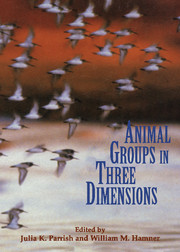Book contents
- Frontmatter
- Contents
- List of contributors
- Acknowledgments
- 1 Introduction – From individuals to aggregations: Unifying properties, global framework, and the holy grails of congregation
- Part one Imaging and measurement
- Part two Analysis
- Part three Behavioral ecology and evolution
- 11 Is the sum of the parts equal to the whole: The conflict between individuality and group membership
- 12 Inside or outside? Testing evolutionary predictions of positional effects
- 13 Costs and benefits as a function of group size: Experiments on a swarming mysid Paramesopodopsis rufa Fenton
- 14 Predicting the three-dimensional structure of animal aggregations from functional considerations: The role of information
- 15 Perspectives on sensory integration systems: Problems, opportunities, and predictions
- Part four Models
- References
- Subject index
- Taxonomic index
14 - Predicting the three-dimensional structure of animal aggregations from functional considerations: The role of information
from Part three - Behavioral ecology and evolution
Published online by Cambridge University Press: 01 June 2010
- Frontmatter
- Contents
- List of contributors
- Acknowledgments
- 1 Introduction – From individuals to aggregations: Unifying properties, global framework, and the holy grails of congregation
- Part one Imaging and measurement
- Part two Analysis
- Part three Behavioral ecology and evolution
- 11 Is the sum of the parts equal to the whole: The conflict between individuality and group membership
- 12 Inside or outside? Testing evolutionary predictions of positional effects
- 13 Costs and benefits as a function of group size: Experiments on a swarming mysid Paramesopodopsis rufa Fenton
- 14 Predicting the three-dimensional structure of animal aggregations from functional considerations: The role of information
- 15 Perspectives on sensory integration systems: Problems, opportunities, and predictions
- Part four Models
- References
- Subject index
- Taxonomic index
Summary
Introduction
A great deal of attention has been devoted to measuring the three-dimensional structure of such animal aggregations as fish and invertebrate schools and bird flocks. Several ingenious techniques, including the shadow method (Dambach 1963; Cullen et al. 1965; Partridge 1980,1981; Partridge et al. 1980), split-frame photography (Cullen et al. 1965; Pitcher 1973, 1975; Healey & Prieston 1973), stereo photography (Symons 1971a, b; Major & Dill 1978; Dill et al. 1981; Hasegawa & Tsuboi 1981; Hasegawa 1982; Klimley & Brown 1983; Koltes 1984; Aoki et al. 1986; O'Brien et al. 1986; O'Brien 1989) and others, have been devised for this purpose. Jaffe (Ch. 2) and Osborn (Ch. 3) detail many of the current methods of three-dimensional data collection. These techniques can generate a large amount of data, sometimes more than one has the time or computing capacity to analyze properly.
Partly for this reason, it seems essential to formulate an hypothesis about aggregation structure before collecting the data. Without an a priori hypothesis, one can wander aimlessly through the database, trying out one transformation after another, seeking evidence of structural pattern. With perseverance and luck, something may emerge, but it will be a descriptive analysis of pattern, and no generality may be implied.
It is therefore surprising that, in contrast to the many detailed descriptive studies of aggregation structure which have been conducted, very little attention has been given to developing theoretical models of spacing behavior within groups. Such theory is needed to predict structural detail such as the preferred nearest neighbor distance, bearing, and elevation.
- Type
- Chapter
- Information
- Animal Groups in Three DimensionsHow Species Aggregate, pp. 207 - 224Publisher: Cambridge University PressPrint publication year: 1997
- 8
- Cited by



